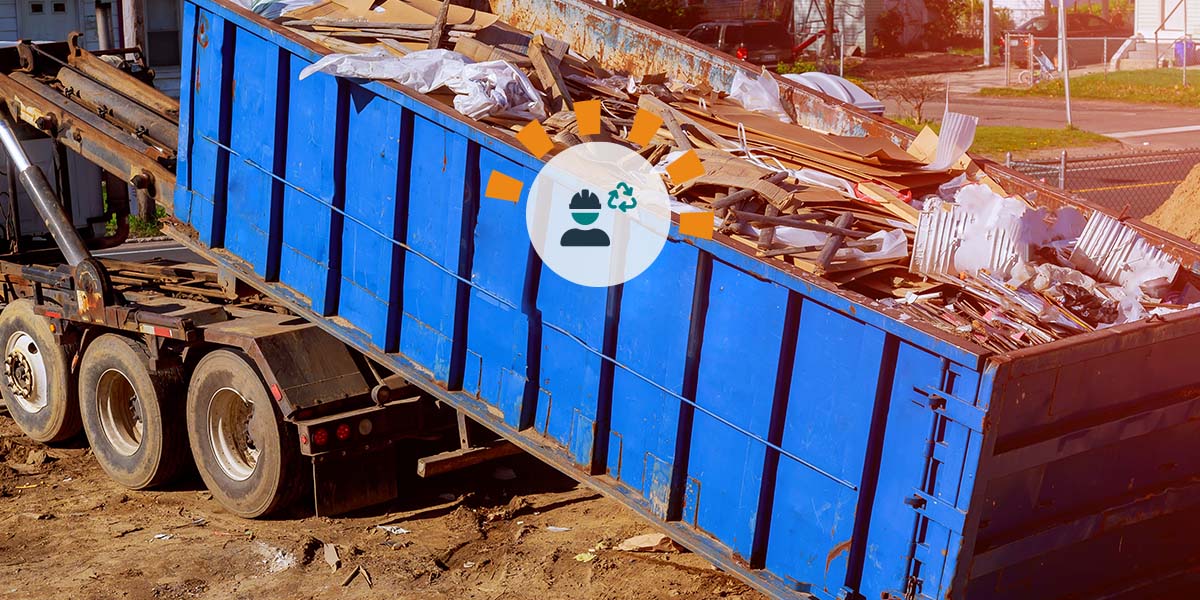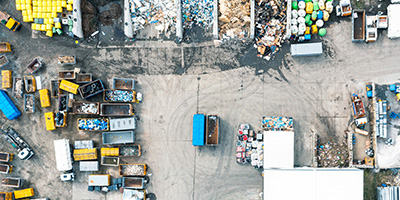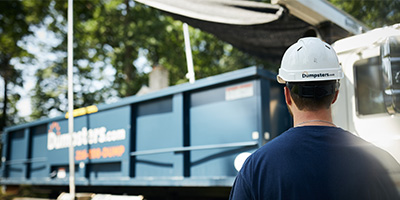How to Recycle Construction Materials From Jobsites
Step up your jobsite recycling game with 6 tips from our team of waste diversion experts.
Make cleanup a breeze with a roll off dumpster:

Construction Waste Recycling Methods for Higher Diversion
Recycling isn’t a new concept. Most cities offer at-home recycling services for homeowners, with the majority of trash companies also offering brick-and-mortar businesses the option of recycling-specific dumpsters. But what happens on a construction site?
While it’s not as simple as tossing it all in a bin and waiting for collection day, construction debris recycling is an increasingly necessary practice as companies work to achieve waste diversion goals — especially for jobs where project owners are seeking various green certifications.
The best news? Nearly all common construction materials can be recycled, including concrete, masonry, wood, asphalt, shingles, metal, glass, plastics, carpet and even insulation. With these tips, you can quickly start recycling on your jobsites.
Construction Waste Recycling FAQs
What are recyclable construction materials?
Nearly all common construction materials can be recycled, including:
- Insulation
- Concrete
- Masonry
- Shingles
- Asphalt
- Plastic
- Carpet
- Metal
- Wood
- Glass
How can you reuse construction waste?
While not all construction waste can be reused, you can still find opportunities to work old construction materials like lumber back into your current or future projects. You can even repurpose environmental waste, such as excavated dirt or uprooted trees and bushes, into the landscaping on a project site.
How is construction waste recycled?
C&D waste is typically sorted either on-site or off-site and taken to a recycling facility, where the materials are prepared for reuse. If you are trying to achieve higher waste diversion for your construction materials, consider reaching out to a dumpster service with recycling container rentals that can take your waste to a local facility for you.
Tip #4: Create a Recycling Plan
You wouldn’t begin construction without an approved set of blueprints to guide your way. So, don’t set a waste diversion goal without mapping out a recycling plan to set you up for success, either.
Your first draft doesn’t have to be flawless — situations come up, and you’ll need to adjust. But if you start with a plan, it’s more likely that you’ll stick to and achieve your recycling goals.
6 Tips to Recycle Construction and Demolition Materials
You can integrate a waste diversion plan into your project from start to finish. While letting a hauling company handle the bulk of the process is a quick and simple way to get the job done, there are a few things you can do to learn how to recycle construction waste — and even handle a bit of the sorting or repurposing before a recycling dumpster is on-site.

Tip #1: Partner With Local Charities
Start the salvaging process before you even get to work. If your project involves demolition, you’ll have to get rid of the debris at some point. Why not dispose of some of it before you even knock down a wall?
Local charities and reclamation stores are often willing to claim — and sometimes even pick up — items they are interested in reselling or using in a future project. If your project’s timeline has the room, reach out to charities such as Habitat for Humanity, Goodwill and The Salvation Army to see what they’re looking for. You may find that they’ll take larger items like doors, cabinets, and kitchen or bathroom fixtures with minimal cost and effort needed on your end.

Tip #2: Make a Materials Reuse Plan
Not everything can be reused, but you can still identify opportunities to work old materials back into your current project or future jobs.
Take the time to comb through your supply list and find ways to reduce the number of construction materials you’ll need to recycle in the first place. Perhaps you can reuse the light fixtures from a demo project in a future build. Or maybe the extra lumber from building a new home will work for a deck railing in an upcoming project.
However, don’t limit yourself to only the materials you’re buying. Consider your surroundings, too. Maybe that dirt you removed when flattening out the plot for a commercial build can be used at the end of the project to re-grade the green space surrounding the new building. Instead of immediately tossing uprooted trees, bushes and plants into a dumpster, consider if those green materials can be transferred to a new location or integrated back into the landscaping.
So, how do you create a materials reuse plan? It really comes down to your workflow and how active your worksites are. These questions will help get you started:
- Does your worksite offer a place for you to store excess materials?
- What items do you know will be sent to a landfill? Do they have to go there?
- If a demo is involved, are any of the materials fit for reuse on this or a future project?
- Do you have any upcoming projects that you can use your leftover or reclaimed materials on?

Tip #3: Know Local Recycling Requirements
To save headaches down the line, make sure to reach out to local recycling facilities to understand their policies. While you’ll find that many facilities accept similar items, you might discover one that takes something different because they have different machinery to process the debris. When reaching out to a recycler, be sure to get answers to questions like:
- What materials do you accept?
- Do you limit the amounts of certain materials?
- Are there any size or weight restrictions for individual pieces of a material?
- Do items like concrete and dirt need to be clean and clear of any attached materials?
Know in advance that this can be time-consuming — especially if you work in multiple cities or nationwide. You’ll often need to make phone calls to several facilities, and it can lead to extra time spent on the jobsite to ensure your construction waste meets the recycling center’s specifications. If you don't want to worry about reaching out to recycling facilities yourself, consider working with a waste provider who consolidates waste disposal and recycling services for you.


While there are many moving parts, start by choosing whether you want on-site or off-site recycling. To put it simply, on-site sorting is where you sort your materials into separate containers on the jobsite. They are then taken to the correct facilities to handle the material type. Off-site sorting is where you place all of your debris into a commingled — or mixed — recycling load, and the facility sorts it for you.
Off-site recycling will usually save you time because you just toss all recyclable materials into one dumpster. For smaller worksites, this might be an ideal solution because there are fewer containers on-site, saving you space. However, it may be more expensive since the facilities often charge more to handle the sorting.
On the other hand, on-site sorting is the best way to recycle as much of your construction debris as possible. It requires more space on your jobsite and potentially more trips to different facilities depending on what is in your area. But you have more overall control of the recycling process. So, consider on-site sorting as your primary method if you have high recycling goals.

Tip #5: Plan and Work in Batches
The less you need to throw out, the easier it is to hit your waste diversion goals. This is particularly important with items that have a short shelf life. Perhaps you’re working with lumber that can’t spend too much time in the rain, or insulation that becomes less effective when exposed to direct sunlight. Knowing how much of that material you’ll need for each section of your project will help you avoid overbuying and letting the excess go to waste.
When possible, it’s also best to work in batches to avoid letting perishable materials go bad. For example, if you know you’ll need caulk for the kitchen, but it can also be used in the two bathrooms, plan ahead to get those rooms completed before the caulk expires — even if it doesn’t completely make sense with the development of the project.
This construction recycling tip helps you as much as it does the environment — the fewer materials you have to throw out, the fewer additional materials you’ll need to purchase, lowering the overall cost of the project.

Tip #6: Partner With a National Waste Hauler
There’s a lot that goes into honing and perfecting your jobsite recycling practices — but you don’t have to do it alone. A national waste hauler with a proven track record will help make your waste diversion plans a reality.
By working with a waste provider like Dumpsters.com, you can save time and effort. We’ll handle the research for you, from what materials are accepted for recycling at your jobsite to any specific rules and restrictions that area facilities may have.
We’ll also set you up with the right containers and haul materials to the appropriate local facilities to keep your project on track and hit your client’s sustainability and recycling goals.
When you rely on the right group, you can rest assured your worksite will get staged with multiple single-stream and commingled containers. Plus, the right waste management company can arrange for swap-outs to ensure you have construction recycling options on-site at all times.
Working with a smaller site? By counting on companies like ours for your trash, you’ll have confidence that your partner will arrange live loads or stagger deliveries to fit your space needs without sacrificing a high waste diversion percentage.
Are You Ready to Achieve Your Construction Recycling Goals?
Trying out just a couple of these tips is bound to help control your waste stream and increase your diversion rate, whether you plan on calling local charities before your next demo or exploring the benefits of on-site vs. off-site sorting. But remember — you don’t have to go on this adventure by yourself. Whether you’re just trying to discover what recycling rates are possible for you or you’re working with a large national corporation that expects lofty diversion rates, our team is ready to help you form a recycling plan that will take your business to the next level.
What Do You Think?
Have thoughts on recycling tips for construction? We're listening. Head over to Twitter, LinkedIn or Facebook,
and use #dumpstersblog to join the conversation.







